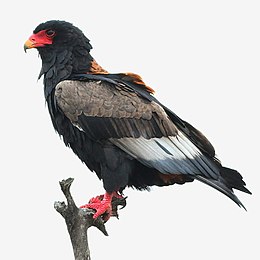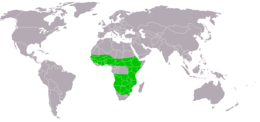
Back Berghaan Afrikaans عقاب الحكيم Arabic عقاب حكيم ARZ Terathopius ecaudatus AST Kiizey (Terathopius) AVK Terathopius ecaudatus Azerbaijani Àguila batallaire Catalan Terathopius ecaudatus CEB Orlík kejklíř Czech Eryr cwta Welsh
| Bateleur | |
|---|---|

| |
| Scientific classification | |
| Domain: | Eukaryota |
| Kingdom: | Animalia |
| Phylum: | Chordata |
| Class: | Aves |
| Order: | Accipitriformes |
| Family: | Accipitridae |
| Subfamily: | Circaetinae |
| Genus: | Terathopius Lesson, 1830 |
| Species: | T. ecaudatus
|
| Binomial name | |
| Terathopius ecaudatus (Daudin, 1800)
| |

| |
| approximate breeding range | |
The bateleur (/ˌbætəˈlɜːr, ˈbætəlɜːr/;[2] Terathopius ecaudatus), also known as the bateleur eagle, is a medium-sized eagle in the family Accipitridae. It is often considered a relative of the snake eagles and, like them, it is classified within the subfamily Circaetinae.[3] It is the only member of the genus Terathopius and may be the origin of the "Zimbabwe Bird", the national emblem of Zimbabwe.[4] Adult bateleurs are generally black in colour with a chestnut colour on the mantle as well as also on the rump and tail. Adults also have gray patches about the leading edges of the wings (extending to the secondaries in females) with bright red on their cere and their feet. Adults also show white greater coverts, contrasting with black remiges in males, gray patches on the underwing primaries and black wingtips. The juvenile bateleur is quite different, being largely drab brown with a bit of paler feather scaling. All bateleurs have extremely large heads for their size, rather small bills, large feet, relatively short legs, long, bow-like wings and uniquely short tails, which are much smaller still on adults compared to juvenile birds.[5][6]
This species is native to broad areas of Sub-Saharan Africa and scarcely up into Arabia. It is characteristically a bird of somewhat open habitats such as savanna with some trees present and open dry woodland.[5] It is in life history, a rather peculiar bird of prey with a free-wheeling generalist diet that includes much carrion but also tends to hunt a wide range of live prey, including many small to unexpectedly relatively large mammals and reptiles along with generally relatively small birds.[7] Bateleurs are highly aerial birds that spend much time soaring and will frequently fly with exaggerated embellishments, perhaps when excited or angered.[8] They tend to build a relatively small if sturdy stick nest in a large tree and lay only a single egg.[5] Despite being a rather aggressive bird in other contexts, bateleurs are easily flushed from their own nest, making them exceptionally vulnerable to nest predators, including humans, and nest failures.[9] It may take as long as 7 to 8 years to attain full maturity, perhaps the longest stretch to maturity of any raptor.[5][7] This species has long been known to be declining rather pronouncedly in overall population and it is mostly confined to protected areas today.[10][11][12] Currently the IUCN classifies the bateleur as an Endangered species due primarily to anthropogenic causes such as habitat destruction, pesticide usage and persecution.[1]
- ^ a b BirdLife International (2020). "Terathopius ecaudatus". IUCN Red List of Threatened Species. 2020: e.T22695289A174413323. doi:10.2305/IUCN.UK.2020-3.RLTS.T22695289A174413323.en. Retrieved 19 November 2021.
- ^ Wells, John C. (2008). Longman Pronunciation Dictionary (3rd ed.). Longman. ISBN 978-1-4058-8118-0.
- ^ Kemp, A. C., G. M. Kirwan, and D. A. Christie (2020). Bateleur (Terathopius ecaudatus), version 1.0. In Birds of the World (J. del Hoyo, A. Elliott, J. Sargatal, D. A. Christie, and E. de Juana, Editors). Cornell Lab of Ornithology, Ithaca, NY, USA.
- ^ "Zimbabwe Bird". victoriafalls-guide.net.
- ^ a b c d Ferguson-Lees, J.; Christie, D. (2001). Raptors of the World. Houghton Mifflin Harcourt. ISBN 0-618-12762-3.
- ^ Hockey, P.A.R.; Dean, W.R.J. and Ryan, P.G. 2016. Roberts VII Birds of Southern Africa. John Voelcker Book Fund.
- ^ a b Steyn, P. (1983). Birds of prey of southern Africa: Their identification and life histories. Croom Helm, Beckenham (UK). 1983.
- ^ Watson, R. T. (1989). Aggressive display and territoriality of the bateleur Terathopius ecaudatus. African Zoology, 24(2), 146-150.
- ^ Herholdt, J. J., Kemp, A. C., & Du Plessis, D. (1996). Aspects of the breeding status and ecology of the Bateleur and Tawny Eagle in the Kalahari Gemsbok National Park, South Africa. Ostrich, 67(3-4), 126-137.
- ^ Brown, L. & Amadon, D. (1986). Eagles, Hawks and Falcons of the World. The Wellfleet Press. ISBN 978-1555214722.
- ^ Thiollay, J. M. (2007). Raptor declines in West Africa: comparisons between protected, buffer and cultivated areas. Oryx, 41(3), 322-329.
- ^ Garbett, R., Herremans, M., Maude, G., Reading, R. P., & Amar, A. (2018). Raptor population trends in northern Botswana: A re-survey of road transects after 20 years. Biological Conservation, 224, 87-99.
© MMXXIII Rich X Search. We shall prevail. All rights reserved. Rich X Search
